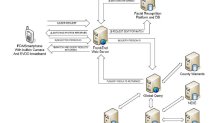When the Tactical Identification System (TACIDS) or facial recognition software was first implemented in San Diego County in 2013, it was considered a research and development effort funded by the National Institute of Justice. Then there were 134 devices among 67 certified law enforcement personnel. In 2016, SANDAG figures requested by NBC 7 Investigates show there are 433 devices used by 991 law enforcement personnel in San Diego County.
According to SANDAG and agencies using this technology, the software is primarily used by officers in the field to identify a person they feel is not being truthful about their identity. It’s also used to help determine if an individual is a threat, by allowing an officer to obtain an individual’s criminal history and past records within minutes.
Opponents raise concerns that the technology is being used on non-consenting individuals who are not suspected of a crime and that the program’s real goal is to collect as much information as possible on those who come in contact with law enforcement. SANDAG and agencies using this technology adamantly deny this.
Eric Hanson, a retired National City Firefighter and Ocean Beach resident, said, in the summer of 2013, Hanson and another neighbor had an argument with a homeless man after they say they spotted the man looking into a neighbor’s window.
"We approach him at the church and say ‘We caught you peeping’ and he didn't deny it," he said.
According to Hanson, a witness called 911.
Local
When San Diego Police officers arrived on scene, Hanson said he didn’t have his ID on him. Hanson said officers ordered him to sit on a curb while they took his photo and ran it through the facial recognition software. He said he had not agreed to being photographed.
"I was violated kinda," Hanson said. "You know I'm pretty open-minded about a lot of stuff. And I'm sure in certain cases it would be beneficial to society in itself, but it's not beneficial to walk around and grab anybody, and take their picture."
The San Diego Police Department confirmed with NBC 7 Investigates that officers made contact with Hanson. He was not arrested or charged with a crime. The department was not able to provide any more details on the incident.
David Loy, legal director for ACLU of San Diego and Imperial Counties said he has "serious concerns" about law enforcement using facial recognition software.
"This technology has enormous capacity to invade personal privacy by allowing law enforcement to compile, in effect, digital dossiers on people's actions and movements throughout the city and the community," he said.
SANDAG and law enforcement disagree.
"The photos that we take from this camera are not stored or added to any database," Lt. Scott Wahl, spokesman for the SDPD said. "The only photos used are photos from the sheriff's department booking database. So if you've never been booked at a county jail, this device isn't going to be nearly as useful of a tool."
SANDAG insists all photos taken in the field by officers and submitted to the Automated Regional Justice Information System, or ARJIS, Facial Recognition Platform (FRP) are not stored anywhere in their systems. According to SANDAG, officers in the field are required to manually delete the photos from their phone or tablet, regardless of whether or not the system finds a matching booking photo.
Wahl said SDPD has a policy in place on when and how officers use facial recognition software. According to that policy, officers are not required to ask for the individual’s permission to take their photo using facial recognition software if they suspect the individual of being involved with a crime.
In 2013 when the program was first implemented, it had a budget of more than $100,000, all paid for by the U.S. Department of Justice.
Recent figures obtained by NBC 7 Investigates show the project’s budget was more than $800,000 in 2014. According to SANDAG, federal grants along with payments from each San Diego County agency primarily fund the program now.
According to data obtained by NBC 7 Investigates, from 2013 to 2015 the number of devices being used in San Diego County increased by over 200 percent. The number of authorized users increased by over 1,300 percent.
The SDPD is the agency using facial recognition software the most, according to the data, conducting over 7,900 queries since the software was implemented.
Every law enforcement agency in San Diego County uses it, including the San Diego Unified School District and local colleges like San Diego State University and University of California, San Diego.
Loy said law enforcement is not being transparent enough about how the software is being used.
"Under what circumstances and how, is data being collected and obtained and stored?" he said. "Who has access? For what purposes can they be used?"
Wahl said SDPD understands people's concerns and officers are working to protect people's privacy, not abuse it.
"This tool is one that isn't used to invade people's privacy," Wahl said. "It's used as a tool to improve the way that we police."
According to SANDAG, the ARJIS Facial Recognition Platform (FRP) only contains images of individuals who have been arrested in San Diego County. It does not have access to any other law-enforcement databases.
That means, if an individual has a criminal record anywhere besides San Diego County, according to SANDAG the database would not produce a match.
Through public records requests, NBC 7 Investigates found there are over 400,000 individuals in the ARJIS Facial Recognition Platform or database. The ARJIS FRP produced 7700 matches since 2013 for officers submitting photos out in the field.

HOW IT WORKS
Through the California Public Records Act, NBC 7 Investigates was able to obtain manuals and training documents detailing how facial recognition devices and the system works.
Below is a description and images from SANDAG describing the technology.

Using a "TACIDS" or facial recognition capable device, an officer can take a picture of an individual and send it via text to ARJIS’ Facial Recognition Platform (FRP). The devices are described as tablets or smartphones that have access to the ARJIS app and the capability to submit photos into the ARJIS database.
Using a biometric algorithm, the FRP will produce a lineup of possible matches, comparing the original photo to thousands of San Diego County booking photos.

When the officer reviews this lineup and finds a possible match, the officer can select the match and resubmit it into ARJIS’ web server, separate from the Facial Recognition Platform. This will produce a long list of local, state and federal criminal records, records from the DMV and/or any warrants active for the individual.
According to SANDAG, obtaining these records traditionally can take days, but with the facial recognition technology, the information is available within minutes.

NBC 7 Investigates is working for you. If you have more information about this or other story tips, contact us: (619) 578-0393, NBC7Investigates@nbcuni.com. To receive the latest NBC 7 Investigates stories subscribe to our newsletter.



